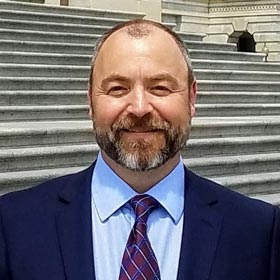
Here's what we'll cover:
What is an Assistive Technology Professional (ATP)?
While we cover the ins and outs of what an ATP is over in our article dedicated to that topic, getting a refresher is always a help.
In a nutshell, an ATP is an assistive technologies expert who compassionately works alongside the entire healthcare team of a client, and the client themselves, to fit and/or create the seating, positioning, and complex rehabilitation equipment needed for them to enjoy their best access to life.
We’re blessed to have an incredible team of ATPs here at Action who have all undergone — and continually build upon — extensive training to become the trusted experts they are today.
But this team, and the individuals who continually put in the hours required to be the best ATPs in the industry, didn’t just happen by chance.
Let’s dive deeper into what it takes to become an ATP and how you can know whether or not it’s the career choice for you.
For those driven by solving complex problems, working with life-changing technology, and creating meaningful and positive change in the lives of those you serve, you’d be hard pressed to find a more fulfilling career. TweetHow can someone become an ATP?
Becoming an ATP requires a lot of time and effort, with only the most passionate and dedicated professionals ultimately achieving their full certification. That said, there are many roads to become an assistive technology professional beyond the typical collegiate path.
As long as an individual has finished high school or earned their GED and fulfilled specific work hour requirements (anywhere from 1500-6000 hours), they can apply for an exam permit. Here are the basic prerequisites for RESNA ATP certification:
With a HS diploma or GED: 30 hours of AT training and 6000 hours of experience in a relevant field over 10 years.
Associate’s Degree in non-rehab science: 20 hours of AT training and 4000 hours of experience in a relevant field over 6 years.
Associate’s Degree in rehab science: 3000 hours of experience in a relevant field over 6 years.
Bachelor’s Degree in a non-rehab science: 10 hours of AT training and 2000 hours of experience in a relevant field over 6 years.
Bachelor’s Degree in rehab science: 1500 hours of experience over 6 years.
Any Master’s Degree: 1000 hours of experience in a relevant field over 6 years.
As you can see, RESNA’s requirements change based on a person’s educational attainment and type of Bachelor’s or Associate’s degree, if applicable. However, qualifying for the exam doesn’t make a person an ATP. That’s decided when an individual actually passes the test.
Once an ATP is RESNA-certified, they’ll need to hone their skills and stay up-to-date with recent developments within the industry. Many registered professionals attend numerous conferences, seminars, and conventions to provide the best possible care.
What are the traits and characteristics of an effective ATP?
An effective ATP’s traits are equal parts soft and hard skills, with some situations calling more for one than the other.
Compassionate
Living with a disability is a challenge all on its own, but adding the adjustment period of learning about a new piece of assistive technology can complicate things further. That’s why it’s absolutely essential that ATPs are compassionate when working with clients and their families.
It’s one thing to cognitively acknowledge that a person is going through a hard time, but it’s completely different to feel their pain and want to do everything to alleviate it.
Compassionate ATPs recognize their roles as sources of direction and potential solutions and use it to empower and encourage their clients through the inevitable hard times.
Diligent
Diligence is critical when you’re caring for a person’s life. For ATPs, this means working tirelessly to meet challenging deadlines and exploring all possible options before settling on a single solution.
Without diligence, there’s a much greater risk of oversight and misunderstanding – which can be fatal in some cases. After all, a large slice of the individuals ATPs work with have a long list of very detailed requirements that must be carefully considered to arrive at the optimal solution.
That said, the importance of diligence extends outside of care contexts. It also branches into keeping up with the latest developments in assistive technology by participating in workshops and seminars.
Flexible
Assistive technology, at its core, is all about adaptability and flexibility – and the same is required of professionals who specialize in this field.
Assistive technology is an active field of work closely tied to medical developments, meaning that old ideas are often challenged and overturned by new research and testing. As a result, an ATP’s methods must change and adapt with the times.
People-oriented
Like with any care-focused profession, ATPs have to be incredibly people-oriented to succeed. Their day-to-day life is filled with caring for patients, corresponding with families, and working closely with other medical professionals – all of which require a passion for people.
Ultimately, everything about being an assistive technology professional is centered around compassionate service and catering solutions to their specific needs, a potential ATP must be passionate about people living their best lives.
What is the exam process for becoming an ATP?
The RESNA ATP certification exam is notoriously difficult, but it is manageable if you know what you’re signing up for.
The 200-item test runs for four hours and is split into five categories – all essential for becoming an effective ATP:
Assessments of need (30%)
Development of intervention strategies (27%)
Implementation of intervention (25%)
Evaluation of intervention (15%)
Professional conduct (3%)
All in all, the test is designed to assess your comprehensive ability to serve people with disabilities and provide them with the expert guidance and recommendations they and their care teams need to achieve the best health outcomes possible.
A Profession that Blends Technical Expertise and Tireless Compassion
Choosing to become an assistive technology professional isn’t for the faint of heart. It takes long hours of study and a large and continual investment of physical, mental, and emotional energy to do your best work day in and day out.
But for those of you driven by solving complex problems, working with life-changing technology, and creating meaningful and positive change in the lives of those you serve, you’d be hard pressed to find a more fulfilling career.
Contact our team of compassionate CTAs and get the technologies you need to keep you, or your loved one, moving.
Let's Work Together
